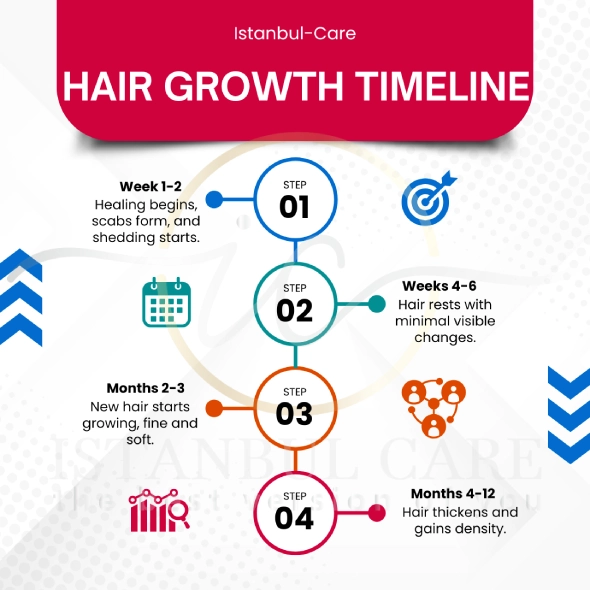What Is The Hair Transplant Recovery Time?
How Long Does Recovery Take?
The recovery period after a hair transplant varies among individuals but generally follows a similar timeline:
- First 1-2 Weeks: Initial healing occurs, with scabs forming and falling off naturally.
- Months 1-3: Transplanted hair may shed, entering a resting phase before new growth begins.
- Months 3-6: Noticeable new hair growth starts, with hairs appearing finer initially.
- Months 6-12: Hair continues to thicken and gain density, approaching the final result.
Complete recovery and full hair maturation typically occur within 12 months post-procedure.
When Can You Expect New Hair Growth After A Hair Transplant?
Hair Growth Timeline
New hair growth usually commences around three to four months after the transplant. Initially, the hair may be fine and sparse but will progressively thicken over time. Significant improvements in hair density are often observed between six to nine months, with full results visible after 12 months.
Immediate Post-Operative Care (Days 1-7)
Following your hair transplant surgery, you’ll enter the critical immediate post-operative phase. Here’s what to expect and how to care for your scalp during this period:
-
-
- Pain Management: Your surgeon will prescribe medications to manage any discomfort or pain.
-
- Reducing Swelling: Applying cold compresses can help reduce swelling around the forehead and eyes.
-
- Protective Measures: Avoid touching or scratching the transplanted area, and consider wearing a loose hat or headscarf for added protection.
- Hygiene Practices: Follow your hair surgeon’s instructions for gently cleaning the recipient area to prevent infections and promote healing.
-

Early Recovery (Days 8-14)
During the early recovery phase, you may experience initial shedding of transplanted hairs. Here’s how to navigate this stage effectively:
-
-
- Gentle Hair Care: Start washing your hair gently using mild shampoos recommended by your surgeon.
-
- Activity Limitations: Avoid strenuous activities, heavy lifting, and excessive bending to prevent straining the scalp and grafts.
- Monitoring Progress: Keep a close eye on the healing progress of both the donor and recipient areas, and inform your surgeon promptly of any concerns.
-

Continued Recovery (Weeks 2-4)
In weeks 2-4 post-surgery, you’ll notice a gradual decrease in swelling and discomfort. Focus on these aspects during this phase:
-
-
- Patience with Hair Growth: Be patient as new hair growth begins; initial growth may appear thin and sparse.
-
- Gradual Return to Activities: Gradually resume regular activities and exercise routines, avoiding excessive sweating or trauma to the scalp.
- Scalp Protection: Protect your scalp from direct sunlight by wearing a hat or using sunscreen to prevent sunburn and aid in healing.
-
Long-Term Recovery and Growth (Months 2-12+)
As you progress into long-term recovery, significant improvements in hair density and appearance will become apparent. Keep the following in mind:
-
-
- Follow-Up Visits: Attend scheduled follow-up appointments with your surgeon for progress tracking and guidance.
-
- Styling and Maintenance: Start styling your hair as desired and consider treatments like coloring or styling products, following your surgeon’s advice.
- Patience for Full Results: Understand that visible improvements are noticeable within months, but complete results may take a year or longer as transplanted hairs thicken and mature.
-
Successfully navigating the hair transplant healing stages requires patience, adherence to post-operative care instructions, and regular communication with your surgeon. By following these guidelines and understanding what to expect at each stage, you can achieve optimal results and enjoy the natural-looking, healthy hair you desire.

Why It Takes Nearly a Year for Hair to Grow Back After a Hair Transplant
Hair growth follows a natural cycle comprising growth (anagen), transition (catagen), and resting (telogen) phases. After transplantation, hair follicles undergo these phases, leading to gradual growth. This cyclical process is why full results are typically observed around 12 months post-procedure.
What To Expect During Post-Operative Recovery
Post-operative recovery involves managing mild discomfort, adhering to care instructions, and monitoring the healing process. Regular follow-ups with your surgeon ensure any concerns are addressed promptly, contributing to successful outcomes.
Regarding Medication and Supplements After a Hair Transplant
Post-transplant, your surgeon may recommend medications such as minoxidil (Rogaine) to enhance hair growth. It’s important to consult with your healthcare provider before starting any new medications or supplements to ensure they are safe and appropriate for your situation.
Post-Hair Transplant, What To Do and Not Do
Do:
- Keep your scalp clean and follow washing instructions provided by your surgeon.
- Sleep with your head elevated to reduce swelling.
- Use prescribed medications to manage pain and prevent infection.
Don’t:
- Engage in strenuous activities or exercise during the initial recovery period.
- Expose your scalp to direct sunlight without protection.
- Pick or scratch at scabs or the transplanted area.
Factors That May Impact Recovery Time
Several factors can influence how quickly and effectively you recover, including:
- Individual healing ability
- Proper post-op care
- Lifestyle habits (e.g., smoking, alcohol consumption)
- The skill and technique of the surgeon
Sleep and Rest Guidelines
Resting properly after your hair transplant is essential for a smooth recovery. Sleep with your head slightly elevated for the first few days to minimize swelling and avoid pressure on the transplanted area.
Speak with our expert Hair Transplantation specialists

Speak with our expert Hair Transplantation specialists
We’re ready to answer your questions
Frequently Asked Questions
The healing process involves four key stages: immediate recovery (1-7 days), scabbing and shedding (2-4 weeks), initial regrowth (3-6 months), and full results (6-12 months).
The shedding phase, also known as shock loss, usually occurs between 2-4 weeks post-transplant. It is a normal part of the healing process.
To enhance healing, follow post-op care instructions, avoid touching the grafts, stay hydrated, and follow a healthy diet.
Final results are visible within 6-12 months, with most patients experiencing full hair regrowth by the end of a year.
It is generally recommended to wait at least 7-10 days before wearing a hat to avoid putting pressure on the newly transplanted follicles. A loose-fitting cap may be acceptable after this period.
Most surgeons advise gently washing your hair 48-72 hours after the procedure using a mild shampoo and avoiding direct water pressure on the scalp.
Yes! With advanced techniques and skilled surgeons, FUE transplants provide a natural hairline and density, blending seamlessly with existing hair over time.

